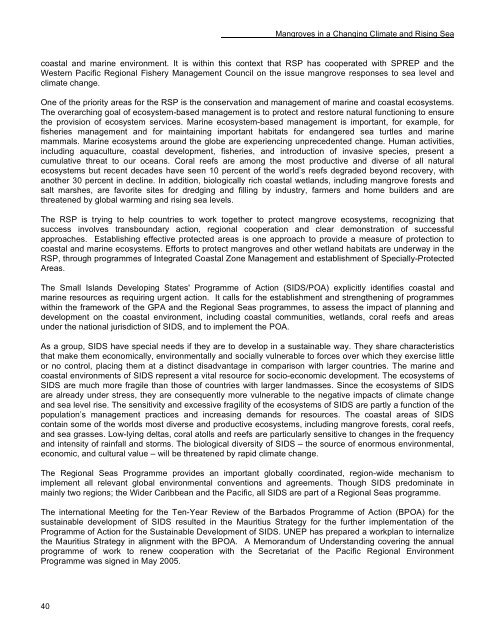Pacific Island Mangroves in a Changing Climate and Rising Sea
Pacific Island Mangroves in a Changing Climate and Rising Sea
Pacific Island Mangroves in a Changing Climate and Rising Sea
Create successful ePaper yourself
Turn your PDF publications into a flip-book with our unique Google optimized e-Paper software.
40<br />
<strong>Mangroves</strong> <strong>in</strong> a Chang<strong>in</strong>g <strong>Climate</strong> <strong>and</strong> Ris<strong>in</strong>g <strong>Sea</strong><br />
coastal <strong>and</strong> mar<strong>in</strong>e environment. It is with<strong>in</strong> this context that RSP has cooperated with SPREP <strong>and</strong> the<br />
Western <strong>Pacific</strong> Regional Fishery Management Council on the issue mangrove responses to sea level <strong>and</strong><br />
climate change.<br />
One of the priority areas for the RSP is the conservation <strong>and</strong> management of mar<strong>in</strong>e <strong>and</strong> coastal ecosystems.<br />
The overarch<strong>in</strong>g goal of ecosystem-based management is to protect <strong>and</strong> restore natural function<strong>in</strong>g to ensure<br />
the provision of ecosystem services. Mar<strong>in</strong>e ecosystem-based management is important, for example, for<br />
fisheries management <strong>and</strong> for ma<strong>in</strong>ta<strong>in</strong><strong>in</strong>g important habitats for endangered sea turtles <strong>and</strong> mar<strong>in</strong>e<br />
mammals. Mar<strong>in</strong>e ecosystems around the globe are experienc<strong>in</strong>g unprecedented change. Human activities,<br />
<strong>in</strong>clud<strong>in</strong>g aquaculture, coastal development, fisheries, <strong>and</strong> <strong>in</strong>troduction of <strong>in</strong>vasive species, present a<br />
cumulative threat to our oceans. Coral reefs are among the most productive <strong>and</strong> diverse of all natural<br />
ecosystems but recent decades have seen 10 percent of the world’s reefs degraded beyond recovery, with<br />
another 30 percent <strong>in</strong> decl<strong>in</strong>e. In addition, biologically rich coastal wetl<strong>and</strong>s, <strong>in</strong>clud<strong>in</strong>g mangrove forests <strong>and</strong><br />
salt marshes, are favorite sites for dredg<strong>in</strong>g <strong>and</strong> fill<strong>in</strong>g by <strong>in</strong>dustry, farmers <strong>and</strong> home builders <strong>and</strong> are<br />
threatened by global warm<strong>in</strong>g <strong>and</strong> ris<strong>in</strong>g sea levels.<br />
The RSP is try<strong>in</strong>g to help countries to work together to protect mangrove ecosystems, recogniz<strong>in</strong>g that<br />
success <strong>in</strong>volves transboundary action, regional cooperation <strong>and</strong> clear demonstration of successful<br />
approaches. Establish<strong>in</strong>g effective protected areas is one approach to provide a measure of protection to<br />
coastal <strong>and</strong> mar<strong>in</strong>e ecosystems. Efforts to protect mangroves <strong>and</strong> other wetl<strong>and</strong> habitats are underway <strong>in</strong> the<br />
RSP, through programmes of Integrated Coastal Zone Management <strong>and</strong> establishment of Specially-Protected<br />
Areas.<br />
The Small <strong>Isl<strong>and</strong></strong>s Develop<strong>in</strong>g States' Programme of Action (SIDS/POA) explicitly identifies coastal <strong>and</strong><br />
mar<strong>in</strong>e resources as requir<strong>in</strong>g urgent action. It calls for the establishment <strong>and</strong> strengthen<strong>in</strong>g of programmes<br />
with<strong>in</strong> the framework of the GPA <strong>and</strong> the Regional <strong>Sea</strong>s programmes, to assess the impact of plann<strong>in</strong>g <strong>and</strong><br />
development on the coastal environment, <strong>in</strong>clud<strong>in</strong>g coastal communities, wetl<strong>and</strong>s, coral reefs <strong>and</strong> areas<br />
under the national jurisdiction of SIDS, <strong>and</strong> to implement the POA.<br />
As a group, SIDS have special needs if they are to develop <strong>in</strong> a susta<strong>in</strong>able way. They share characteristics<br />
that make them economically, environmentally <strong>and</strong> socially vulnerable to forces over which they exercise little<br />
or no control, plac<strong>in</strong>g them at a dist<strong>in</strong>ct disadvantage <strong>in</strong> comparison with larger countries. The mar<strong>in</strong>e <strong>and</strong><br />
coastal environments of SIDS represent a vital resource for socio-economic development. The ecosystems of<br />
SIDS are much more fragile than those of countries with larger l<strong>and</strong>masses. S<strong>in</strong>ce the ecosystems of SIDS<br />
are already under stress, they are consequently more vulnerable to the negative impacts of climate change<br />
<strong>and</strong> sea level rise. The sensitivity <strong>and</strong> excessive fragility of the ecosystems of SIDS are partly a function of the<br />
population’s management practices <strong>and</strong> <strong>in</strong>creas<strong>in</strong>g dem<strong>and</strong>s for resources. The coastal areas of SIDS<br />
conta<strong>in</strong> some of the worlds most diverse <strong>and</strong> productive ecosystems, <strong>in</strong>clud<strong>in</strong>g mangrove forests, coral reefs,<br />
<strong>and</strong> sea grasses. Low-ly<strong>in</strong>g deltas, coral atolls <strong>and</strong> reefs are particularly sensitive to changes <strong>in</strong> the frequency<br />
<strong>and</strong> <strong>in</strong>tensity of ra<strong>in</strong>fall <strong>and</strong> storms. The biological diversity of SIDS – the source of enormous environmental,<br />
economic, <strong>and</strong> cultural value – will be threatened by rapid climate change.<br />
The Regional <strong>Sea</strong>s Programme provides an important globally coord<strong>in</strong>ated, region-wide mechanism to<br />
implement all relevant global environmental conventions <strong>and</strong> agreements. Though SIDS predom<strong>in</strong>ate <strong>in</strong><br />
ma<strong>in</strong>ly two regions; the Wider Caribbean <strong>and</strong> the <strong>Pacific</strong>, all SIDS are part of a Regional <strong>Sea</strong>s programme.<br />
The <strong>in</strong>ternational Meet<strong>in</strong>g for the Ten-Year Review of the Barbados Programme of Action (BPOA) for the<br />
susta<strong>in</strong>able development of SIDS resulted <strong>in</strong> the Mauritius Strategy for the further implementation of the<br />
Programme of Action for the Susta<strong>in</strong>able Development of SIDS. UNEP has prepared a workplan to <strong>in</strong>ternalize<br />
the Mauritius Strategy <strong>in</strong> alignment with the BPOA. A Memor<strong>and</strong>um of Underst<strong>and</strong><strong>in</strong>g cover<strong>in</strong>g the annual<br />
programme of work to renew cooperation with the Secretariat of the <strong>Pacific</strong> Regional Environment<br />
Programme was signed <strong>in</strong> May 2005.

















